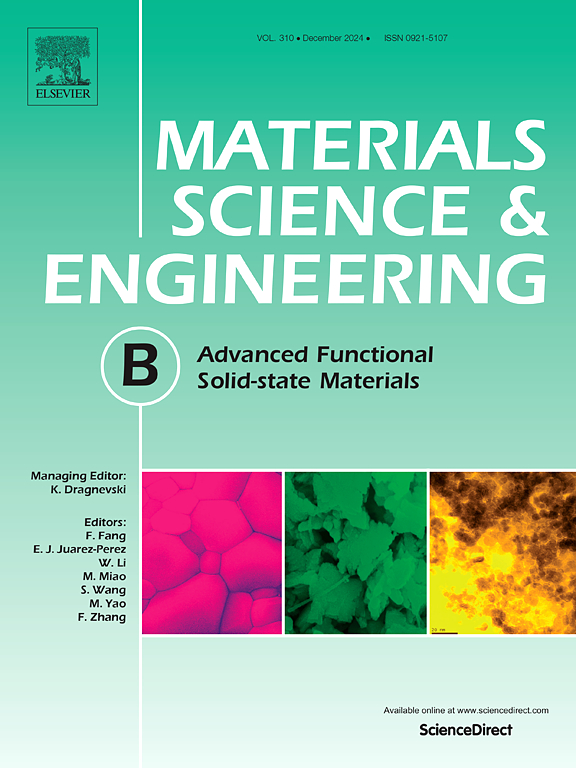喷砂处理对SLM成形Ti-6Al-4V多孔径向梯度支架组织和力学性能的影响
IF 3.9
3区 材料科学
Q2 MATERIALS SCIENCE, MULTIDISCIPLINARY
引用次数: 0
摘要
径向梯度多孔结构符合天然骨的结构特点,通过调节内层和外层孔隙度可以提高其力学性能。然而,选择性激光熔化(SLM)形成的多孔结构表面粗糙度过高是裂纹产生的根源,对力学性能不利。本文采用Gyroid单元胞法设计了6种孔隙率为50% ~ 80%的径向梯度多孔结构和1种均匀多孔结构。采用SLM法制备Ti-6Al4V多孔结构,然后进行喷砂处理。研究了喷砂对复合材料显微组织、压缩性能、变形性能和吸能的影响。结果表明:在已建成的多孔结构中存在许多未熔化的粉末和层状台阶,以及微球形孔隙;喷砂处理后,多孔结构支撑表面的粉末颗粒减少,表面缺陷减少,有利于提高成形精度。此外,微观结构变得更细、更致密。多孔结构的应力-应变曲线由弹性阶段、平台阶段和致密化阶段组成。多孔结构的弹性模量为2.21 ~ 7.80 GPa,屈服强度为54.05 ~ 320.40 MPa,吸能量为20.76 ~ 94.13 MJ/m3。喷砂后,这些参数分别增加到2.97 ~ 8.58 GPa、61.71 ~ 334.92 MPa和20.99 ~ 109.69 MJ/m3。喷砂前后多孔结构均表现出剪切破坏特征。喷砂结构断口呈现韧性和脆性混合断裂特征,而原始结构断口呈现相对脆性断裂特征。此外,Gibson-Ashby预测模型表明,压缩力学特性随相对密度的增加而增加。因此,喷砂可以增加径向梯度多孔结构的强度和韧性,使其更适合骨种植体的应用。本文章由计算机程序翻译,如有差异,请以英文原文为准。
Effect of sandblasting treatment on the microstructure and mechanical properties of Ti-6Al-4V porous radial gradient scaffolds formed by SLM
The radial gradient porous structure conforms to the structural characteristics of natural bone, and its mechanical properties can be improved by adjusting the porosity of the inner and outer layers. However, the high surface roughness of the porous structure formed by selective laser melting (SLM) is source the generation of cracks, and harmful for the mechanical properties. In this work, Gyroid unit cell was employed to design six radial gradient porous structures with porosities ranging from 50 % to 80 %, along with one uniform porous structure. Ti-6Al4V porous structure was prepared by SLM and then sandblasted. The effects of sandblasting on microstructure, compressive properties, deformation behavior and energy absorption were studied. The results show that there are many unmelted powder and layered steps, as well as micro-spherical pores in the as-built porous structure. After sandblasting treatment, the powder particles on the strut surface of the porous structure and the surface defects decrease, contributing to improve the forming accuracy. Additionally, the microstructure becomes finer and denser. The stress–strain curve of porous structure is composed of elastic, plateau and densification stages. The elastic modulus, yield strength and energy absorption of the porous as-built structure are 2.21–7.80 GPa, 54.05–320.40 MPa, and 20.76–94.13 MJ/m3, respectively. After sandblasting, these parameters increase to 2.97–8.58 GPa, 61.71–334.92 MPa, and 20.99–109.69 MJ/m3, respectively. The porous structures both before and after sandblasting exhibited shear failure characteristics. However, the fracture surfaces of the sandblasted structures demonstrated mixed ductile and brittle features, whereas the original structures showed relatively more brittle fracture behavior. Furthermore, the Gibson-Ashby prediction model demonstrates that compressive mechanical characteristics increase with increasing relative density. As a result, sandblasting can increase the strength and toughness of the radial gradient porous structure, making it better suited for bone implant applications.
求助全文
通过发布文献求助,成功后即可免费获取论文全文。
去求助
来源期刊

Materials Science and Engineering: B
工程技术-材料科学:综合
CiteScore
5.60
自引率
2.80%
发文量
481
审稿时长
3.5 months
期刊介绍:
The journal provides an international medium for the publication of theoretical and experimental studies and reviews related to the electronic, electrochemical, ionic, magnetic, optical, and biosensing properties of solid state materials in bulk, thin film and particulate forms. Papers dealing with synthesis, processing, characterization, structure, physical properties and computational aspects of nano-crystalline, crystalline, amorphous and glassy forms of ceramics, semiconductors, layered insertion compounds, low-dimensional compounds and systems, fast-ion conductors, polymers and dielectrics are viewed as suitable for publication. Articles focused on nano-structured aspects of these advanced solid-state materials will also be considered suitable.
 求助内容:
求助内容: 应助结果提醒方式:
应助结果提醒方式:


